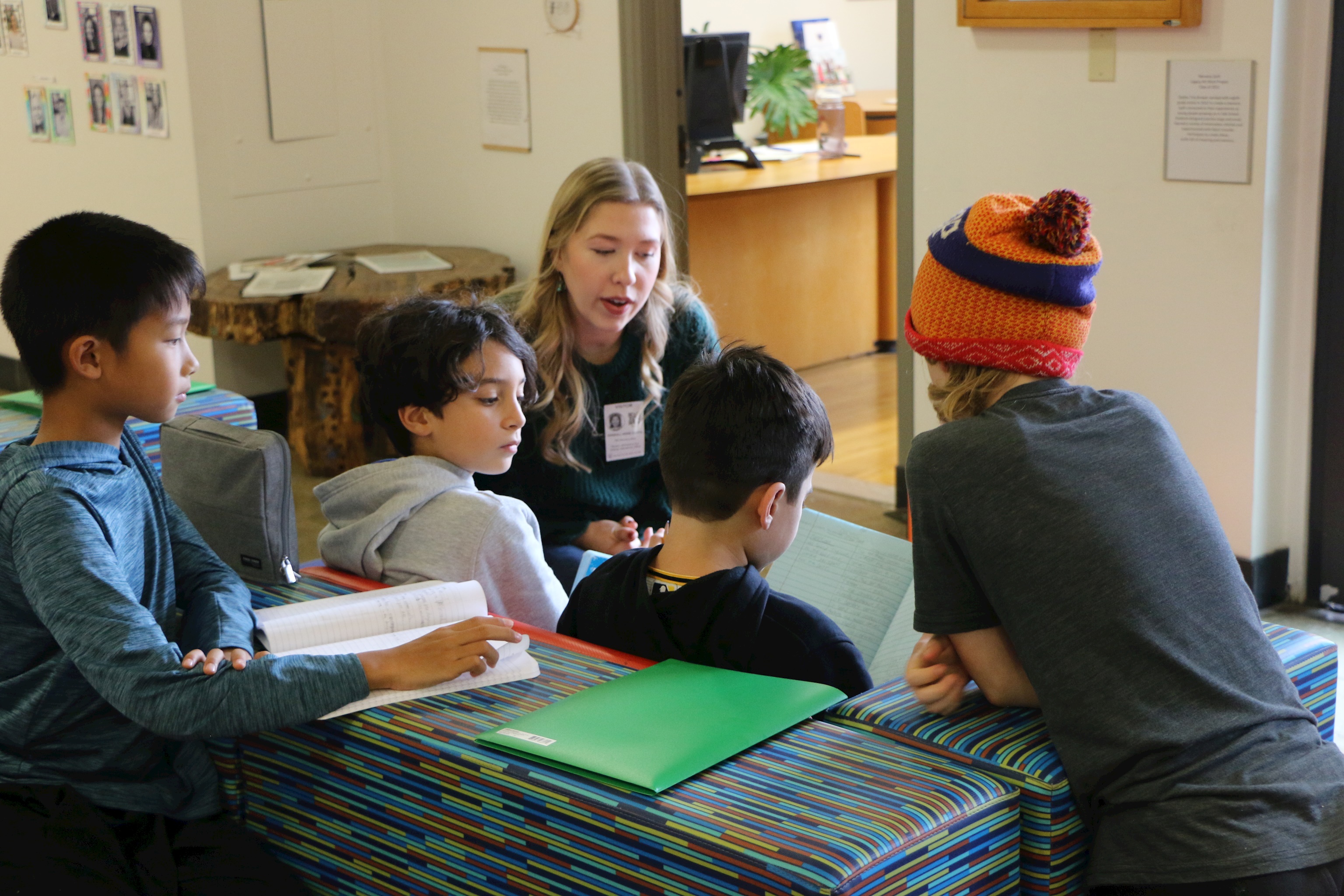Discover our
Home for Learning
- Contact
- 412-624-8020
- [email protected]

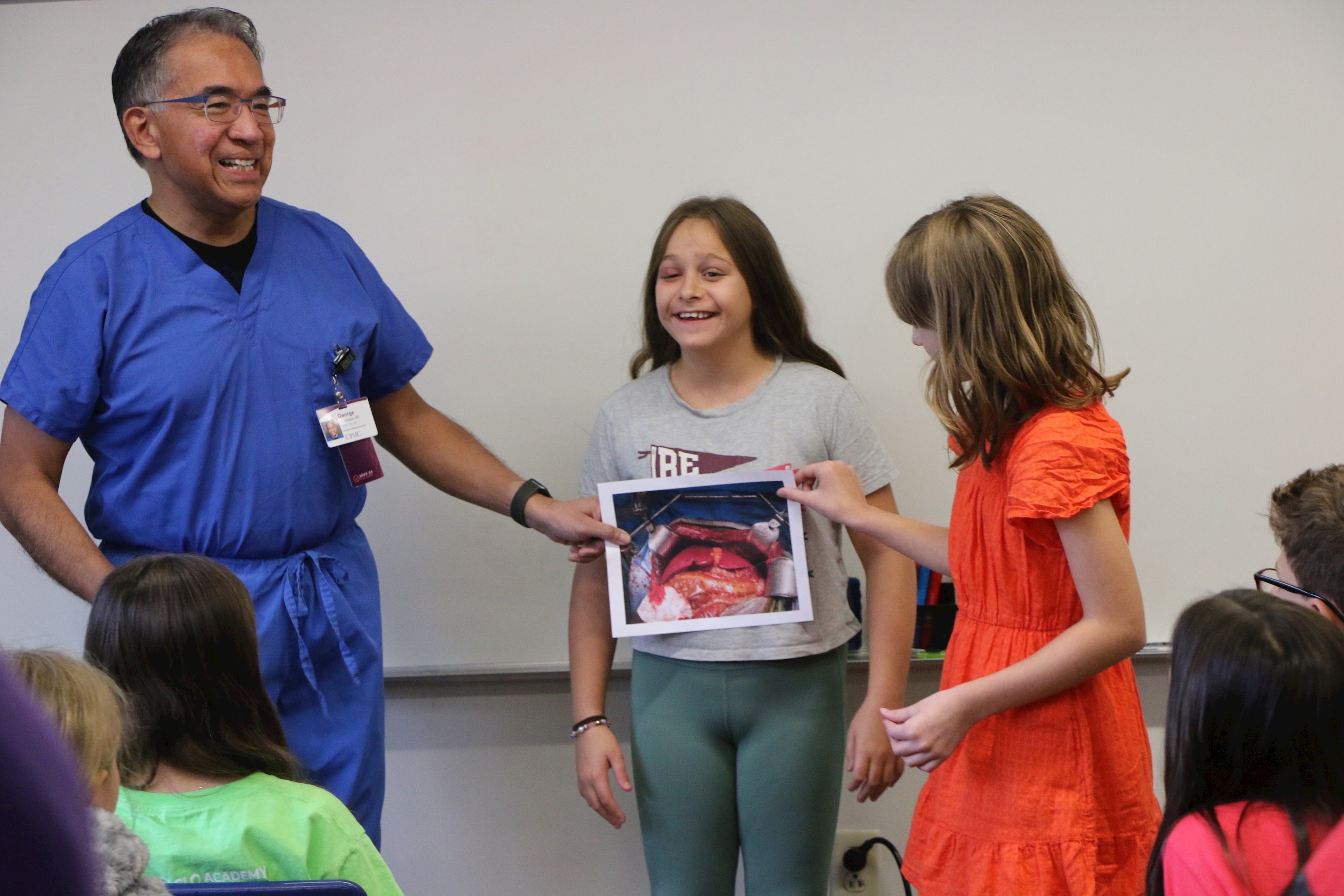
The fifth-grade student holds up the printed image of a liver, positioning it against her classmate’s abdomen.
“What do you think?” guest speaker George V. Mazariegos, Jaimie Lee Curtis in Professor of Pediatric Transplantation Surgery and professor of surgery and of critical care medicine, University of Pittsburgh School of Medicine, asks the class. “Is that the right spot?”
Micah Downs’ and Elizabeth King’s fifth-grade students call out advice.
Mazariegos is discussing the liver and its function with the students, passing around photographs of livers he has seen in his extensive career and a 3D-printed liver complete with colorful blue veins.
A multi-faceted approach to anatomy
Today’s lively presentation, complete with thoughtful questions from the fifth graders, is a fun way to bring the teachers’ anatomy unit to life.

The unit kicked off several weeks earlier when Downs and King welcomed a group of Pitt medical students to their classrooms to deliver short presentations on various body systems—digestive, pulmonary and circulatory, among others—to inspire and intrigue the fifth graders.
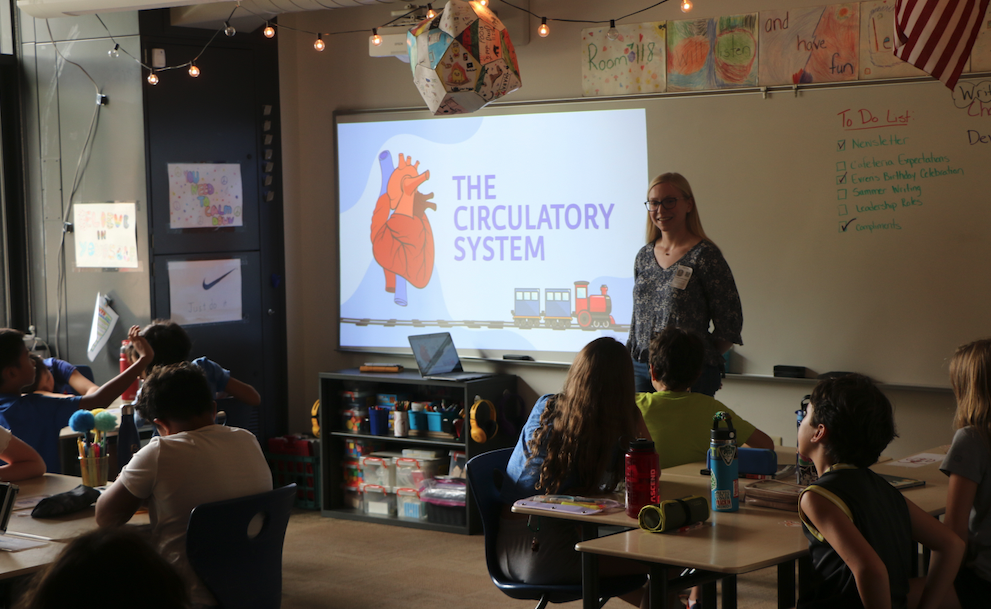
From there, students explore chosen body systems in groups and through fun activities like a digestion demonstration in which Downs strained food through a stocking to illustrate how food moves through the body.
Working in groups, the students spend class time conducting research into six different body systems. Near the end of the term, the medical students will return to help them refine their work, prepare scripts for movies they will make to present their assignments, select appropriate visual aids and film their movies.
“Students will get basic information on the muscles, for example,” says Downs, “but one group will learn about the muscular system in depth.”
Downs and King are fourth- and fifth-grade teachers at Fanny Edel Falk Laboratory School. Their classes are in the second of a two-year loop, meaning that these groups of students spent all of last year together. And because Downs and King have extensive experience teaching together, these fifth graders are especially familiar with one another and can work together easily.
Leaning on their familiarity with each other and their students is just one way Downs and King are leveraging some of Falk Lab School’s signature strengths.
Pulling from the Falk community
Mazariegos is not the last physician to visit Falk fifth graders or the last with a parental connection to the school. (He’s the father of three Falk alumni. “Go Falk!” he tells the fifth graders.)
From conversations with students and their parents, Downs and King became aware that a number of classroom parents work in the medical or scientific fields.
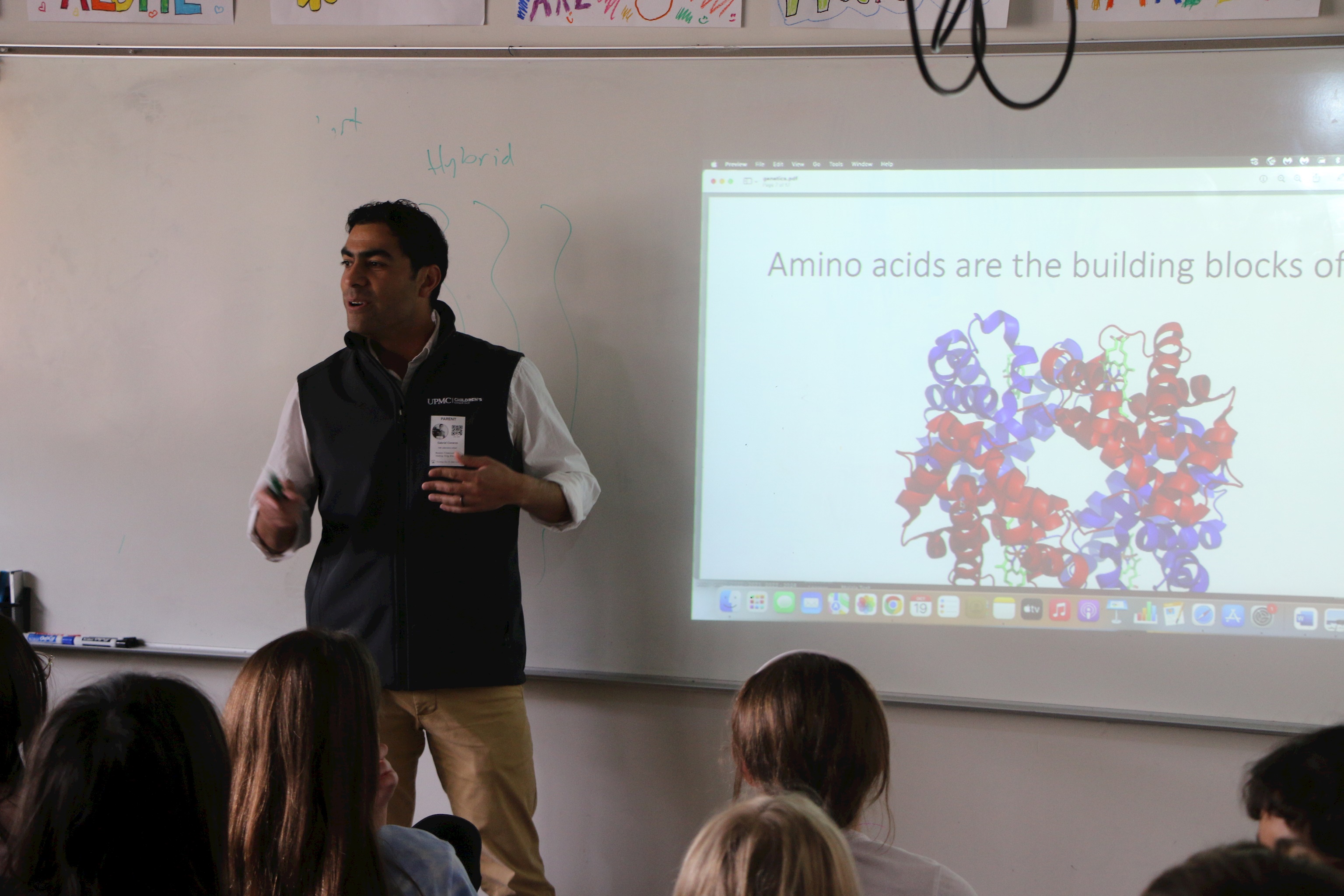 On a Thursday in October, several busy physicians and scientists—all parents of Falk fifth graders—make the trek up Allequippa Street to wait in the back of Downs’ room while the daughter of the first speaker, Gabriel Cisneros, a pediatrician with UPMC Children’s Community Pediatrics, introduces him.
On a Thursday in October, several busy physicians and scientists—all parents of Falk fifth graders—make the trek up Allequippa Street to wait in the back of Downs’ room while the daughter of the first speaker, Gabriel Cisneros, a pediatrician with UPMC Children’s Community Pediatrics, introduces him.
Dr. Cisneros, a primary care pediatrician, discusses genetics and heredity with the students. On the whiteboard, a projector displays a slide of Gregor Mendel, the 19th-century German-Czech monk often credited as the founder of the science of genetics. Cisneros grabs a marker and sketches the heights of the pea plants in Mendel’s famous experiments, which provided the foundation for our understanding of inheritance.
“I was a little nervous going into it,” says Cisneros, who worried the students would be bored or disinterested in the topic of genetics. “But it turned out the opposite—they were hanging on my every word and had so many great questions and observations! They really wanted to understand the science and it was so great to be able to introduce them to this subject.”
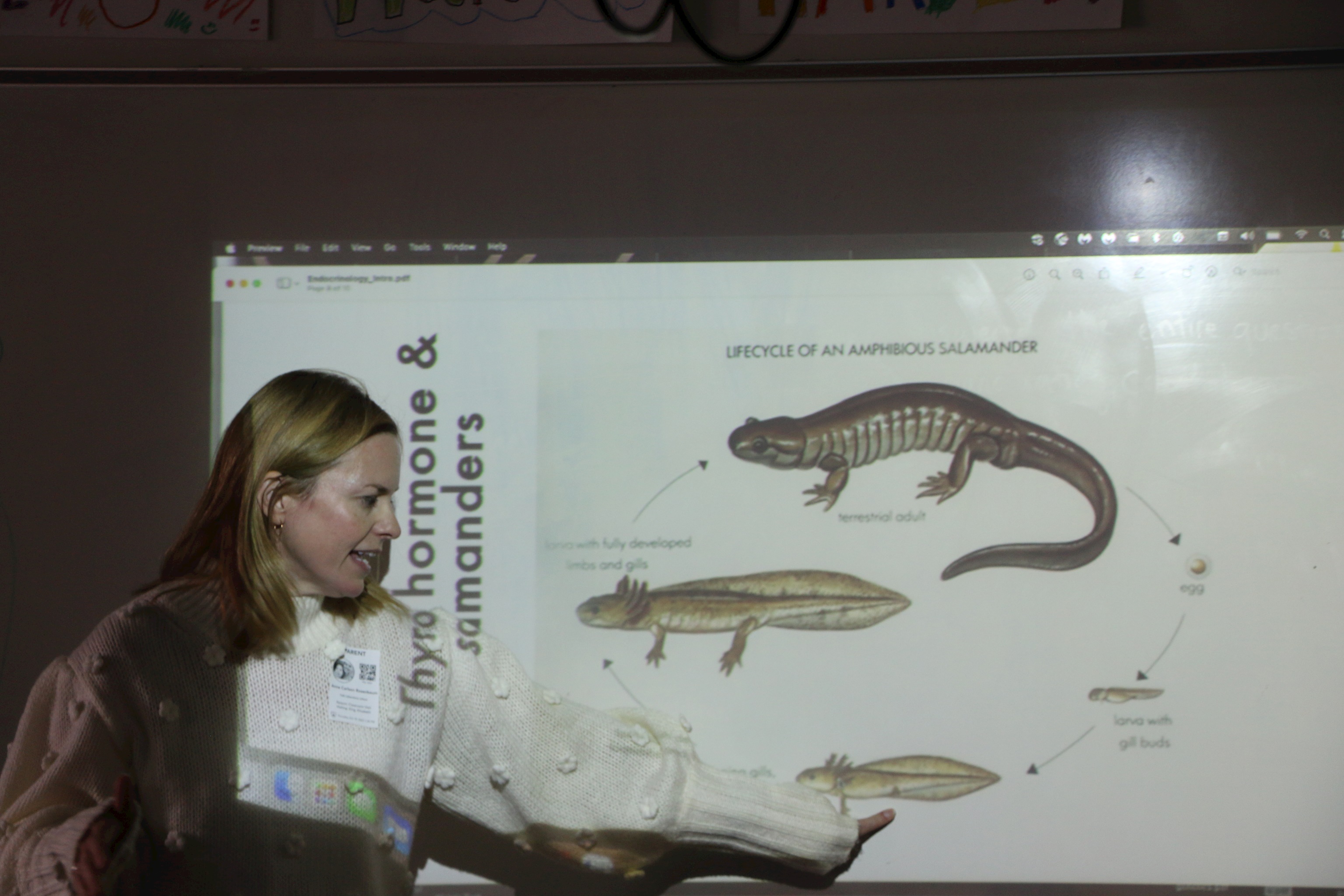 Anne Carlson, associate professor of biological sciences, Kenneth P. Dietrich School of Arts and Sciences, introduces the endocrine system and describes its connection to a number of other bodily systems. She illustrates her talk with slides on cortisol, the thyroid, salamanders and hormones. Carlson presents a slide with Renaissance paintings in which the Virgin Mary and other figures are depicted with goiters, caused by iodine deficiency. The next slide shows a canister of salt with iodide added—a key reason, she says, why goiters are so much less common today.
Anne Carlson, associate professor of biological sciences, Kenneth P. Dietrich School of Arts and Sciences, introduces the endocrine system and describes its connection to a number of other bodily systems. She illustrates her talk with slides on cortisol, the thyroid, salamanders and hormones. Carlson presents a slide with Renaissance paintings in which the Virgin Mary and other figures are depicted with goiters, caused by iodine deficiency. The next slide shows a canister of salt with iodide added—a key reason, she says, why goiters are so much less common today.
“Teaching a room full of fifth graders was louder and slightly more chaotic than my typical classroom filled with graduate students!” says Carlson. “But the visit was completely inspiring. The students were engaged and uninhibited to ask questions and share their thoughts and experiences. Their enthusiasm was infectious! I left the classroom visit grateful that my kids attend a school where their curiosity is nurtured and their voices are valued.”
 After Alicia Haupt, assistant professor of pediatrics, School of Medicine, is introduced by her son, she explains her work with children who require medically complex care. (Haupt is also a pediatrician at the UPMC Children’s Hospital of Pittsburgh Complex Care Center.) She shows growth charts that track the height and weight of young patients over time and discusses alternative ways to get these patients nutrition, including gastrostomy and gastrojejunostomy tubes. Haupt holds up tubing borrowed from her clinic and even passes around a teddy bear with a small gastric port in its belly to demonstrate how small and unobtrusive these tubes can be.
After Alicia Haupt, assistant professor of pediatrics, School of Medicine, is introduced by her son, she explains her work with children who require medically complex care. (Haupt is also a pediatrician at the UPMC Children’s Hospital of Pittsburgh Complex Care Center.) She shows growth charts that track the height and weight of young patients over time and discusses alternative ways to get these patients nutrition, including gastrostomy and gastrojejunostomy tubes. Haupt holds up tubing borrowed from her clinic and even passes around a teddy bear with a small gastric port in its belly to demonstrate how small and unobtrusive these tubes can be.
“Presenting to the students was incredibly rewarding,” says Haupt. “I was in awe of their interest and curiosity. It was enjoyable to have such an interactive experience where I was able to teach material relevant to their studies and hear all of their thoughtful questions and observations. It meant a lot to me to be able to participate.”
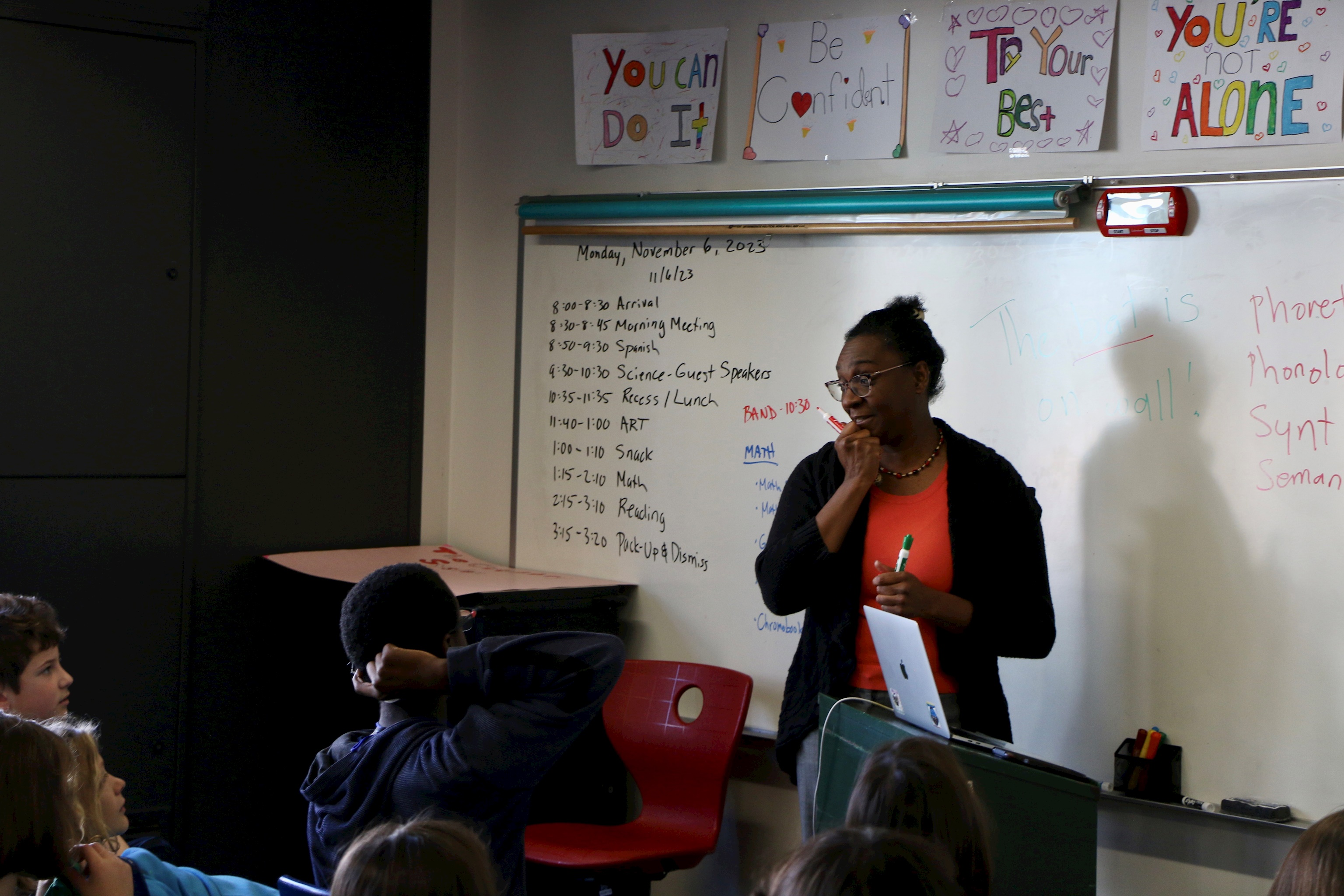 Later in the term, the students are joined by Shelome Gooden, assistant vice chancellor for research in the humanities, arts, social sciences and related fields and professor of linguistics, Kenneth P. Dietrich School of Arts and Sciences, and Finn Calabro, research assistant professor of psychiatry, School of Medicine, and of bioengineering, Swanson School of Engineering.
Later in the term, the students are joined by Shelome Gooden, assistant vice chancellor for research in the humanities, arts, social sciences and related fields and professor of linguistics, Kenneth P. Dietrich School of Arts and Sciences, and Finn Calabro, research assistant professor of psychiatry, School of Medicine, and of bioengineering, Swanson School of Engineering.
Gooden begins by asking the students how they define language. She lights up at one definition that includes both soundwaves and signs. That’s a great answer, she says, because linguistics incorporates elements of both the natural and social sciences. Comparing how the verb “walk” is written in three languages—English, Spanish and Jamaican Creole—Gooden introduces concepts like morphology, phonetics and the social aspects of language. Sharing an audio clip of her son saying his name, she presents a graph of the sounds, explaining how different sounds are made as they exit the throat.
 Calabro tells the students that his research is basically about them: He investigates the growth and development of the adolescent brain. He asks students to match images of brains to the correct animal. Which is the dolphin brain? Which belongs to a cat or a monkey? From there, Calabro pinpoints the areas of the brain responsible for vision, hearing, and other functions, sharing the surprising insight that the brains of all animals are organized in roughly the same way, but differ in how much space they allocate to different functions. Calabro describes the functioning of neurons and shares slides taken from magnetic resonance imaging of his daughter’s brain at age 6 versus another from when she was 10.
Calabro tells the students that his research is basically about them: He investigates the growth and development of the adolescent brain. He asks students to match images of brains to the correct animal. Which is the dolphin brain? Which belongs to a cat or a monkey? From there, Calabro pinpoints the areas of the brain responsible for vision, hearing, and other functions, sharing the surprising insight that the brains of all animals are organized in roughly the same way, but differ in how much space they allocate to different functions. Calabro describes the functioning of neurons and shares slides taken from magnetic resonance imaging of his daughter’s brain at age 6 versus another from when she was 10.
“It was great to see how curious and engaged all the students were, and the fantastic questions they all had,” says Calabro. “Since we study brain development at around their age, it was fascinating to see how they thought the things we study about how the brain works align with their experiences (and when they don’t!)”
The parent experts have helped King and Downs present a fuller and richer picture of the human body, King says, shining a light on both more abstract topics and those so specific that the unit might not otherwise have touched on them.
“It’s difficult to understand the endocrine system at a fifth-grade level,” says King. “So, Dr. Carlson came in and gave an overview. We’ve learned about it, even though no one studied it in depth because it’s a little more difficult to understand.”

Presentations like Cisneros’s or Gooden’s, by contrast, addressed topics that might not be central to understanding the human body but about which Downs and King had noticed their students wondering. Downs recounts hearing students ask why their eyes were a certain color. Noting that genetics were among Cisneros’s interests, the teachers asked if he might speak on that topic.
“The nice thing about our community here at Falk is that we have experts on a lot of things,” says King, “and so to be able to draw on parents’ expertise to come and talk to the kids is powerful. You’ve got an expert here, explaining and answering questions.”
Downs adds, “Fifth grade is a time when kids begin to crystallize their strengths and their interests. They may not be making career choices yet, but they do start to analyze what they might be interested in. To see familiar adults doing something for a living can make a big impact.”
To hear more about the research Calabro is doing, for example, or learning about the kinds of cases Haupt encounters, is similar to events bringing in parents who are authors, conveying the subtle but strong message that these kinds of careers are an option for the students in the classroom.
The fifth-grade students were thrilled to see and learn from familiar faces, and reported feeling especially comfortable asking questions of their classmates’ parents—or their own.
“It was nice to have someone you’re familiar with in the building who I’ve known for most of my life,” reported the child of one of the presenters. “It was nice to learn some new things that I actually didn’t know even though she’s my mother.”
Learning from fellow students
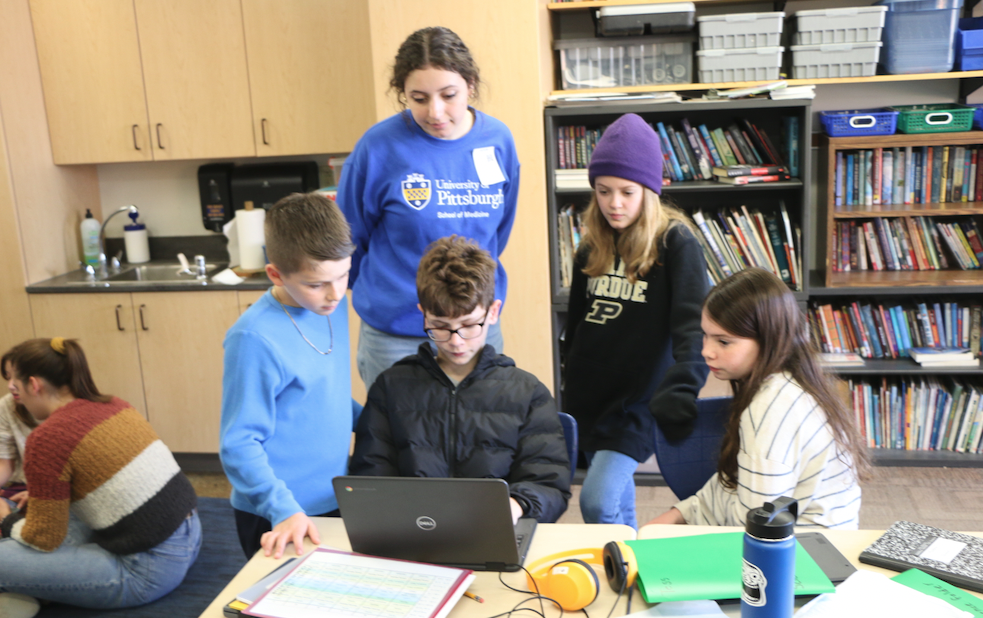
Falk’s connection to the Pitt—including the School of Medicine—has also been a tremendous asset to Downs and King as they planned and delivered this unit. Falk students have not been the only ones to benefit from the association.
The collaboration began with the recognition by Evelyn C. Reis, associate dean for the learning environment, and professor of pediatrics, School of Medicine, and of clinical and translational science, that medical students would benefit by learning typical child development by seeing healthy children on their home turf in settings like the school. Reis and her colleague Erin Elizabeth Cummings, assistant professor of pediatrics (Paul C. Gaffney Division of Pediatric Hospital Medicine), School of Medicine, contacted Eileen Coughlin, chair of Falk science curriculum committee, in hopes of connecting medical students with young people. Coughlin connected Reis and Cummings with Downs and King.
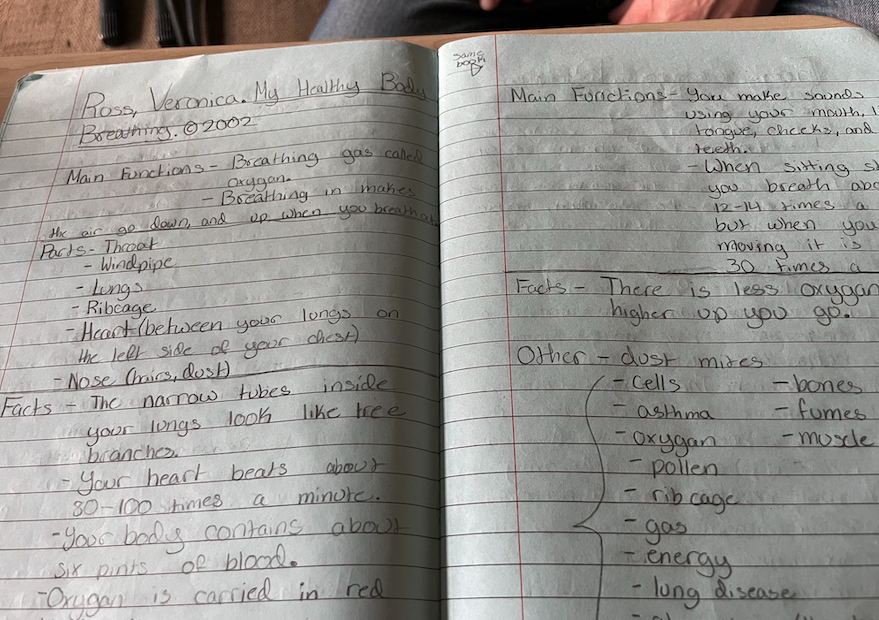
“Currently, exposure to pediatrics takes place solely at UPMC Children’s Hospital of Pittsburgh or other health care settings where children are often ill or anxious,” Reis says. This collaboration would give medical students a fuller picture of child development.
The medical students who participated in the project had all signaled an interest in pediatrics, making their close work with Falk students especially meaningful.
“We all thought it would be cool if the med students worked with kids to talk about the body,” says Downs. “That might help them as doctors working with kids. How do you explain the digestive system to a 10-year-old?”
The medical students were a critical part of getting the fifth graders not only interested in but passionate about different body systems. In their initial presentations, the med students explained why the digestive or circulatory system was the most interesting part of the human body.

“The medical students who volunteered all shared a passion for pediatrics and worked hard to ensure their presentations were extremely interactive, engaging and fun,” says Cummings. “Medical student after medical student stood in front of the classroom and blew us all away with their energy levels, fun facts and command of the classroom. It was truly a joy to watch, and I'm thrilled that it helped spark the fifth-grade students' interest in studying the human body.”
Along with lectures from Downs and King, the med students’ presentations were a terrific way to make sure all Falk students had the basics on each of the body systems.
For the medical students, the benefits of participating in the project have included observing the classroom management of expert teachers, expanding their knowledge of the range of typical child development, including academic and social skills, and developing their ability to communicate with children at this developmental age.
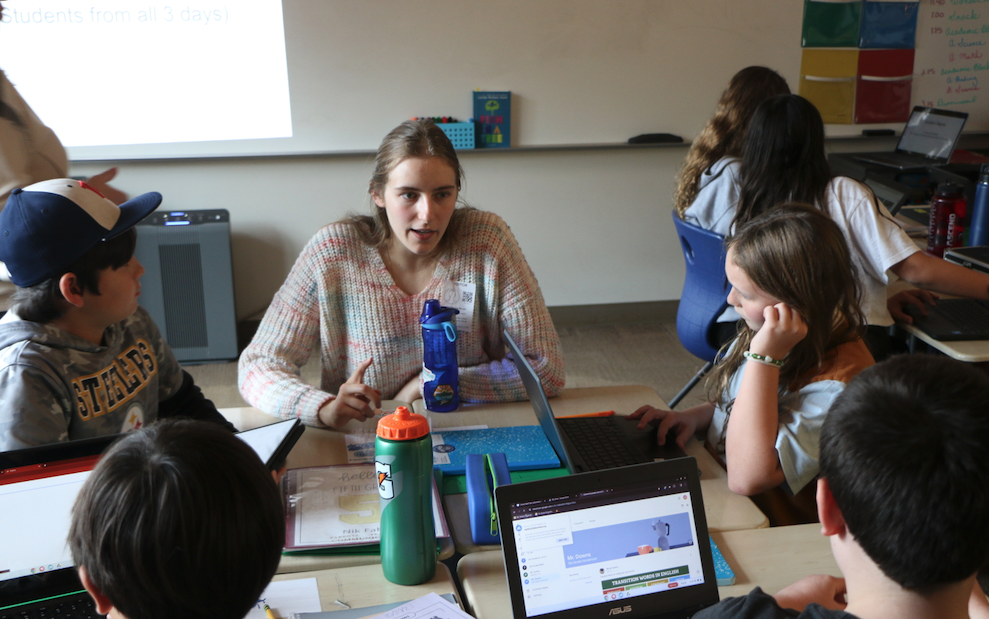
"I really enjoyed volunteering as a science mentor,” recounts one of the medical students. “I learned to not underestimate kids and that sometimes when you think you’re leveling a concept down to help them understand, you are actually holding them back from fully understanding it. I was with the musculature group, and I expected to talk about the muscles from a very gross perspective, but then I had one student draw a sarcomere for me and discuss actin and myosin. I was blown away!"
Other medical students echo that sentiment.
“Their enthusiasm and awe at the complexities of the human body were a gentle reminder of why I decided to study medicine in the first place,” says one student.
“Volunteering at Falk Lab School to help the students with their project was an honor and a blast,” says another. “The kids were so knowledgeable, focused, engaged and fun to work with. A wonderful experience all around, and I’d be happy to come back.”
The Falk students were just as enthusiastic about the opportunity to work with the medical students.
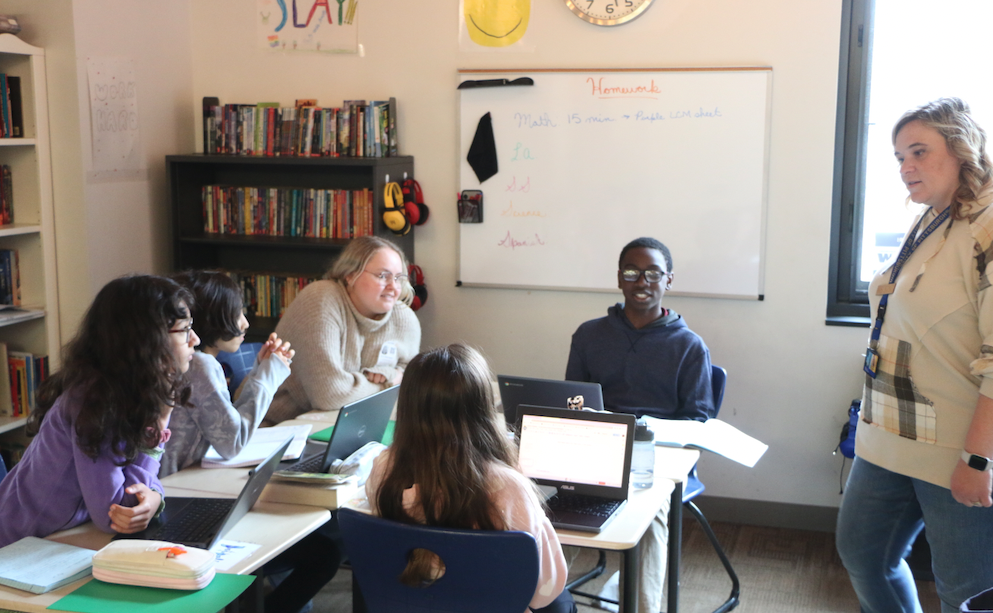
It was nice to be able to ask them questions, says one fifth-grader, “because the books don’t always explain everything.”
“It was really fun to work with them,” says another. “They corrected us when we made mistakes and they taught us a couple things about our systems.”
He adds, “I would recommend to do it again, because it was really fun!”
Reis says, “We are hopeful that this is the first activity of an ongoing collaboration that benefits both Falk School and Pitt medical students.”
